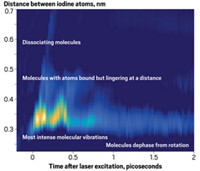Advertisement
Grab your lab coat. Let's get started
Welcome!
Welcome!
Create an account below to get 6 C&EN articles per month, receive newsletters and more - all free.
It seems this is your first time logging in online. Please enter the following information to continue.
As an ACS member you automatically get access to this site. All we need is few more details to create your reading experience.
Not you? Sign in with a different account.
Not you? Sign in with a different account.
ERROR 1
ERROR 1
ERROR 2
ERROR 2
ERROR 2
ERROR 2
ERROR 2
Password and Confirm password must match.
If you have an ACS member number, please enter it here so we can link this account to your membership. (optional)
ERROR 2
ACS values your privacy. By submitting your information, you are gaining access to C&EN and subscribing to our weekly newsletter. We use the information you provide to make your reading experience better, and we will never sell your data to third party members.
Analytical Chemistry
Ultrafast Structural Dynamics Of Biomolecules
by Lauren K. Wolf
March 8, 2010
| A version of this story appeared in
Volume 88, Issue 10

The ability to create stable femtosecond pulses of laser light has given chemists access to the reaction and structural dynamics of a host of biomolecules that were formerly off-limits.
COVER STORY
Ultrafast Structural Dynamics Of Biomolecules
"The real challenge is studying biomolecular structure in the 10-femtosecond to 1-picosecond time domain," says Richard A. Mathies, dean of the College of Chemistry at the University of California, Berkeley. "That's the intrinsic time over which chemical reactions occur."
In the past four decades, in particular, says physics professor Paul M. Champion of Northeastern University, "the laser has allowed vibrational modes of biomolecules to be observed in their natural aqueous environments with both static and time-resolved Raman spectroscopies." And ultrafast techniques have enabled research groups like his to study coherent reaction dynamics in complexes such as heme proteins (Science 1994, 266, 629).
Mathies and coworkers have used time-resolved techniques such as femtosecond absorption spectroscopy and, more recently, femtosecond stimulated Raman spectroscopy (FSRS) to interrogate photochemical reaction dynamics in visual pigments, including rhodopsin. For example, Mathies' group measured the photoisomerization of rhodopsin's chromophore, an important step in vision (Science 1991, 254, 412). And last year, the same group analyzed excited-state structural changes in green fluorescent protein, a common fluorescent tag, during proton transfer (Nature 2009, 462, 200).
Another "hot field" in which scientists are using lasers to observe biochemical reaction dynamics in the condensed phase is two-dimensional infrared spectroscopy, Champion says. The concept of 2-D IR spectroscopy was dreamed up in the 1970s, when nuclear magnetic resonance spectroscopists were learning to do 2-D NMR, says Martin T. Zanni, a chemistry professor at the University of Wisconsin, Madison. "It just couldn't be implemented" without femtosecond infrared laser pulses, he adds.
But within the past 10 years, the technology and know-how have become available, and scientists such as field pioneer Robin M. Hochstrasser of the University of Pennsylvania are now creating 2-D time-resolved structural maps of systems that include peptides and small proteins. Zanni's group recently elucidated an amino-acid-resolved mechanism for the aggregation of amyloid peptides, complexes that are the hallmark of diseases such as Alzheimer's and type 2 diabetes (Proc. Natl. Acad. Sci. USA 2009, 106, 6614).
By applying visible, rather than infrared, femtosecond laser pulses in sequence, researchers can also study biological chromophores and photochemical systems. Graham R. Fleming and his group at UC Berkeley use 2-D electronic spectroscopy to study molecular energy transfer in photosynthesis. These studies, Zanni says, "have shed a lot of light, so to speak, on how plants convert solar energy into chemical energy."



Join the conversation
Contact the reporter
Submit a Letter to the Editor for publication
Engage with us on Twitter